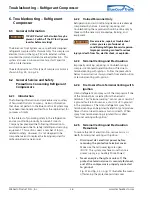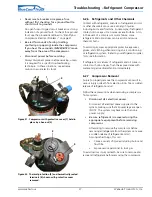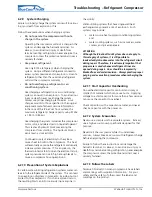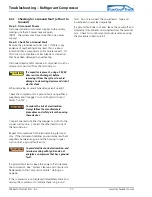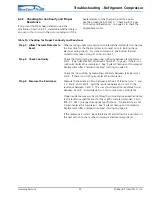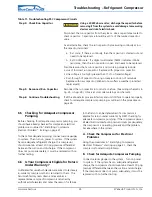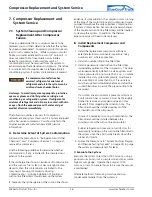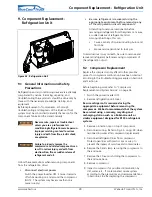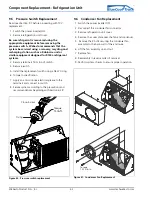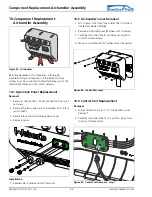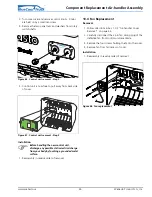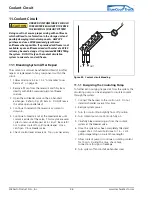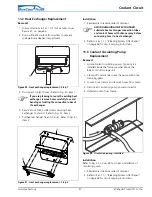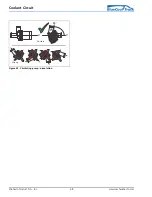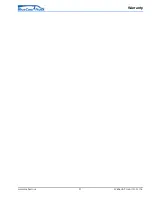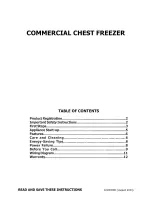
Compressor Replacement and System Service
Webasto Product N.A., Inc.
36
www.techwebasto.com
™
7. Compressor Replacement and
System Service
7.1
System Cleanup and Compressor
Replacement After Compressor
Failure
Once you determine that a compressor needs to be
replaced you must then determine whether the system
has been contaminated. Compressor motor failure can
lead to such contamination. (While compressor motor
failure is sometimes referred to as motor “burnout”, it
does not mean that a fire actually occurs inside a
hermetic compressor.) Even small amounts of
contamination must be removed from the system to
avoid damaging the replacement compressor. Therefore,
it is important to thoroughly clean a refrigeration/air
conditioning system if system contamination is present.
If a compressor motor failure has
occurred, refrigerant or mixtures of
refrigerant and oil in the system can be
acidic and cause chemical burns.
As always, to avoid injury, wear appropriate protective
eye wear, gloves and clothing when servicing an air
conditioning or refrigeration system. If refrigerant or
mixtures of refrigerant and oil come in contact with skin
or eyes, flush the exposed area with water and get
medical attention immediately.
The following outlines a process for compressor
replacement and system clean-up for a system equipped
with a Tecumseh compressor. You should refer to the
original equipment manufacturers (OEM) service
information.
A. Determine Extent of System Contamination
Following the precautions in “Refrigerants and Other
Chemicals” and “Compressor Removal” on page 27,
remove the compressor.
Use the following guidelines to determine whether
contamination, if any, is limited to the compressor or
extends to the system.
If the discharge line shows no evidence of contamination
and the suctions tub is clean or has only light carbon
deposits, then the contaminants are limited to the
compressor housing (Compressor Housing
Contamination). A single installation of liquid and
suction line filter-driers should clean up the system.
If, however, the discharge line or the suction line shows
evidence of contamination, the compressor was running
at the time of the motor failure and contaminants were
pumped throughout the system (System Contamination).
If System Contamination has occurred, several changes
of the liquid and suction line filter-driers will be needed
to cleanup the system. In addition, the thermal
expansion valve will need to be replaced.
B. Install Replacement Compressor and
Components
1. Install the replacement compressor with new
external electrical components (capacitors, relay,
overload, etc., where applicable).
2. Install an oversized liquid line filter-drier.
3. Install a generously sized suction line filter-drier
immediately upstream of the compressor. The drier
when permanently installed in a clean system must
have a pressure drop not more than 2 psi, or initially
installed in a dirty system temporarily, must have a
pressure drop not more than 9 psi. Pressure taps
must be supplied immediately before and after the
suction filter-drier to permit the pressure drop to be
measured.
If a suction line accumulator is present and System
Contamination has occurred, it must be thoroughly
flushed to remove any trapped sludge and thus
prevent if from plugging the oil return hole. The
filter-drier should be installed upstream of the
accumulator and the compressor.
In case of Compressor Housing Contamination, the
filter-drier should be installed between the
compressor and the suction line accumulator.
Rubber refrigeration hoses are not satisfactory for
temporarily hooking up the suction line filter-drier to
the system since the acid quickly breaks down the
rubber and plastic.
4. Follow the Precautions in “System Flushing, Purging,
and Pressure Testing for Leaks” on page 28, to purge
the system and pressure test for leaks.
C. Evacuate the System
Evacuate the system to less than 1000 microns, using a
good vacuum pump (not a compressor) and an accurate
high vacuum gauge. Operate the pump at 1000
microns, or less, for several hours to be sure the vacuum
is maintained.
Alternate method of removing moisture and non-
condensable material from the systems is:
WARNING





